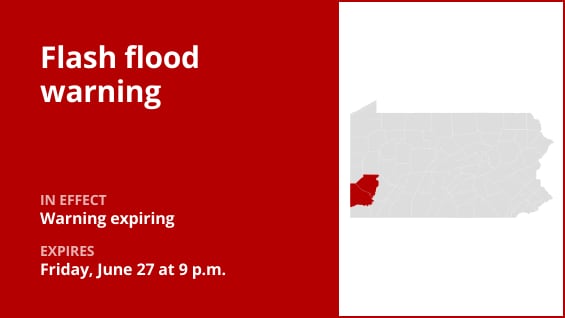Allegheny and Washington counties were included in the notice.
The waters of the flood have subsided. It is no longer anticipated that flooding will be a hazard. Please keep paying attention to any remaining road closures. According to the National Weather Service, parts of Pennsylvania and northern West Virginia are under a flood watch through midnight.
Deciphering advisories, watches, and warnings: Understanding weather alerts
-
Flash flood warning: Take action!
When a flash flood is approaching or already happening, a warning is sent. Get to high ground right away if you’re in a flood-prone location. A flash flood is a quick, intense flood that can form in a matter of minutes to hours. Even in places that don’t get rain right away, flash floods can happen.
-
Flood warning: Take action!
When flooding is expected or is happening, a flood warning is issued.
-
Flood advisory: Be aware:
When flooding is not predicted to become severe enough to warrant a warning, a flood advisory is issued. However, it still has the potential to be extremely inconvenient and, if careless, to result in circumstances that endanger life and/or property.
-
Flood watch: Be prepared:
When the weather is conducive to flooding, a flood watch is issued. Although it doesn’t ensure flooding will happen, it does indicate that it is a potential.
When floods strike: Guidelines from the weather service for your protection
Floods can be a serious hazard, particularly if you live in a flood-prone location or camp in a low-lying area. The weather service provides crucial flood protection instructions to protect you:
Look for higher ground.
Moving to higher ground should be your first course of action if you’re camping in a low-lying location or in an area that is prone to flooding.
Respect evacuation directives:
Immediately comply with any evacuation orders issued by local authorities. Make sure your house is locked before you leave.
Cut off appliances and utilities:
Disconnect your appliances and utilities if you have the time. By taking this precaution, electrical dangers during flooding are reduced.
Steer clear of waterlogged regions and basements:
Avoid basements or rooms with electrical outlets or cords submerged in water. This lessens the chance of electrical mishaps.
Quickly leave for your safety:
Evacuate right away if you see sparks or hear popping, crackling, snapping, or buzzing noises. Avoid going into water that might be electrically charged.
Avoid the floodwaters:
Never try to cross flooding on foot. Six inches of quickly flowing water can knock you off your feet with force.
If you’re stuck, look for high ground:
If you find yourself caught by flowing water, move to the highest spot you can and dial 911 to reach rescue personnel.
Flooding is a possibility during periods of high rainfall, particularly in low-lying and flood-prone locations. Never drive on water on the road, even if it appears to be shallow. The weather service claims that most cars can be washed away by as little as 12 inches of swiftly moving water. Be knowledgeable and ready to stay safe.
Rainy roadways ahead: Essential safety tips for heavy rain
There is a greater chance of floods and dangerous roadways when it rains a lot. The weather service has provided the following advice to help you keep safe during downpours:
Watch out for swift water flow:
Avoid parking or strolling close to drainage ditches or culverts during periods of intense rain, since the swift-moving water can be quite dangerous.
Keep your distances from other vehicles safe:
Keep a safe distance from the automobile ahead of you by following the two-second rule, and give yourself an extra two seconds if it’s raining a lot.
Reduce your speed and exercise caution:
Reduce your speed if it’s raining and the roads are wet. Reduce your speed gently by taking your foot off the accelerator. Never apply the brakes abruptly since this could cause the vehicle to slide.
Pick your lane carefully:
Water tends to pool in the outside lanes, so stick to the central ones.
Put visibility first:
Turn on your headlights to improve visibility in severe rain. Rain-stained windows can make it difficult to see cars in blind zones, so be especially alert for them.
Be cautious on slick roads:
Because of a combination of rain, oil, and grime, roadways are at their slickest during the first 30 minutes of precipitation. Be especially careful during this time.
Stay a safe distance away from big cars:
Avoid following buses or big vehicles too closely. Their big tires produce a mist that blurs your eyesight. Additionally, be cautious when passing them; if you have to, pass swiftly and securely.
Be mindful of your wipers:
-
Overloaded wiper blades can hinder visibility. If rain severely limits your sight, pull over and wait for conditions to improve. Seek refuge at rest areas or protected spots.
-
If the roadside is your only option, pull off as far as possible, preferably past the end of a guard rail, and wait until the storm passes. Keep your headlights on and turn on emergency flashers to alert other drivers of your position.
You may greatly lower dangers and protect your health when it rains a lot by adhering to these safety precautions. To ensure a safe and sound voyage, keep yourself updated on weather conditions and follow local authorities’ instructions.
United Robots offers a service called Advance Local Weather Alerts that gathers the most recent information from the National Weather Service using machine learning.






